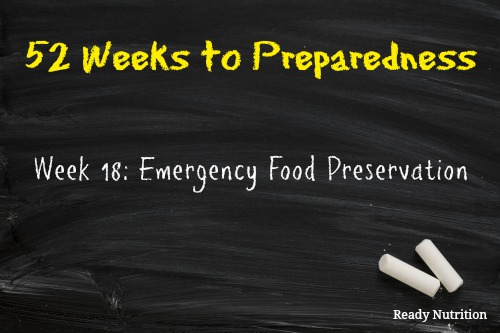
Acquiring items to preserve food is a good investment for your short and long-term disaster supplies. However, to start this new skill set out, it is best to begin with collecting various types of food preservation resources. Some of the books that I have in my library are:
- The Prepper’s Cookbook
- Little House on the Prairie Cook Book
- The Dehydrator Bible
- Canning and Preserving Your Own Harvest
A great advantage about learning how to preserve food is that you can use just about any type of food. You can even preserve your own fruit juice. All you need is the right tools and your imagination. Further, having knowledge on how long foods last will help you preserve foods when they are at their best. This convenient food storage chart is a great tool to have in your kitchen to ensure your foods are within expiration.
Food preservation can be done in multiple ways:
- Canning – This process destroys microorganisms and inactivates enzymes that are naturally in food. The heating and later cooling forms a vacuum seal to prevent other microorganisms from decontaminating the food within the jar or can. Acidic foods such as fruits and tomatoes can be processed or “canned” in boiling water (also called the “water bath method”), while low acidic vegetables and meats must be processed in a pressure canner at 240°F (10 pounds pressure at sea level). Because the food is canned at the time of the fruits/vegetables prime nutrient content, they will retain most of their nutritional content if not gain more nutrients from the canning process. Canned food will keep 12 months, if not lot longer, in some cases.
- Freeze – This is by far, the easiest way to preserve your food. Many simply, boil their fruits or vegetables for a minute or two and then throw them in the freezer. I have a vacuum sealer and seal up ready-to-cook dinners have them sitting in my freezer to use for nights when I’m really busy. It’s best to eat frozen food within 6-12 months. This is a very time efficient way of preserving food, however, if the electricity goes out for an extended time, the food will spoil. So my advice is to not put all your “eggs in one basket”, if you know what I mean.
- Drying or Dehydrating – This method is a very low cost approach to use for long term storage is a great way of including needed nutrition into diets with minimal investment. You can purchase a food dehydrator for as low as $40, or you can dehydrate foods in the oven at a very low setting. Some people have even used their cars as a dehydrator during the hot, summer months. This type of preservation method keeps foods for 6 months-12 months. Dehydrating foods is the only long-term storage method for meat (jerky) which is a great food source to add to your 72-hour bag. Here are a few more recipes you may want to try out. To learn more about dehydrating and storing tips, click here.
- Cure & Smoke – This time honored preservation method is very popular due to the intense flavor it adds to meats. Many foods are cured before smoking, especially cold-smoking, to draw out the moisture, which would otherwise promote spoilage. Ensure that you use cure mixtures that contain nitrate. Caution: Nitrites are considered carcinogens and are toxic if used in quantities higher than recommended; therefore caution should be used in their storage and use. Curing is when a mixture of salt, sodium nitrate, nitrites, sometimes sugar, spices, and other seasonings are combined to kill off any bacterial growth and to flavor the meat at the same time. To learn more about curing and smoking meats, click here.
- Fermenting and pickling – This method of food preservation is one of the most common ways to prolong food sources because the acidity level makes it difficult for bacteria to grow. Ensure that you select fresh, firm fruits or vegetables free of spoilage. Distilled vinegar or cider vinegars of 5 percent acidity (50 grain) are recommended. To learn more about this type of preservation, click here.
Like with all foods in our food storage pantry, ensure that food is stored away properly in a cool, dark place away from natural elements (sunlight, moisture and insects). Natural elements and insects are your food’s worst enemies and should be avoided at all costs.
Food preservation is one of the oldest technologies known to man. Civilizations and even armies depended on preserved foods. And for centuries, this skill has been seen as a survival necessity. It is time that we took a second look at the skills from our ancestors and re-learn them to use for our future suvival situations.
Preps To Buy:
- Kosher Salt (10 lbs.)
- Sugar (20 lbs.)
- Morton’s Sure Curing Salt (10 lbs.)
- Pickling Salt (5-10 lbs.)
- White Vinegar and Apple Cider Vinegar (5-10 gallons)
- Molasses (5-10 lbs)
- Powdered Fruit Pectin
- Canning Jars (in an assortment of sizes), lids and rings
- Food Drying Racks
- Pressure Canner
- Food strainer
- Canning rack
Action Items:
1. Begin researching and finding resources to have on hand for the different food preservation methods discussed. There are some great resources for preserving food on different homesteading websites and even homesteading magazines.
2. Practice makes perfect! So, start practicing using these methods in order for it to become a skill.
3. Start a garden to that you can grow food to preserve for later use.
This article was originally published at Ready Nutrition™ on September 2nd, 2011







I also recommend Bells Blue Book for canning. It tells you many different methods of canning and what I like about this one is canning using the pressure cooker and the time/pressure needed.
Lot quicker.